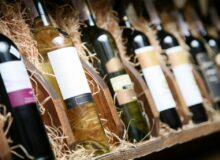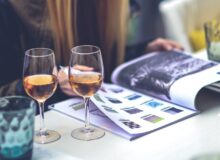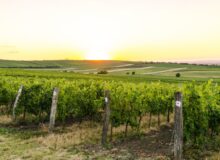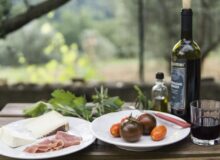Babbalucci is a new Italian restaurant in South Tampa and there’s going to be a focus on Southern Italy. I like this place. Brought to you by Chef Felix from the popular Spanish Tampa restaurant Viscaya; I have previewed the menu and the wine list and I recommend you get in there to try this food and wine while they are getting their feet wet. It’s great. The veal dishes are great, so are the pork chop dishes. The pasta is homemade…The best Sea Bass in town. Yes, it’s Italian!
There’s a bar for cocktails upstairs and an outside view. Very Cool. Feels like a Bistro in places. Now that does not mean that there won’t be your traditional fair of pasta dishes…but expect something truly different and expect some interesting wines. The best time to try restaurants is when it first opens. You’ll get a sense of how things really are as they get everything in gear.
Chances are you’ll eat something that you’ll love and it won’t be on the menu too long. It’s all about getting everything started. It’s the same with the wine. Italian wines are vast and they go great with food. Totally recommend it. Good place to eat and hang out. With the good food, bar, cocktails, music and dancing. It makes you wonder if spirit of Viscaya will blend into this restaurant somehow; because it has that feel.
So, let’s talk about the wines of southern Italy in some detail. The wine is a lot different that the Central and Northern Italian wines….To me they are more voluptuous; more memorable.
Three regions to look at are Campania, Puglia and Sicily…
Campania:
Campania, the region surrounding the city of Naples, is at the center of southern Italy’s wine renaissance. This is home to the Amalfi Coast, the isle of Capri, Mt. Vesuvius, and of pizza. The rich soil and temperate climate here are ideal for growing all kinds of fruits and vegetables. Grapes are no exception.
Campania’s top three wines come from the Irpinia hills area, just outside of Naples: the red Taurasi, and the white Fiano di Avellino and Greco di Tufo wines.
Taurasi is a full-bodied red that requires aging, like its northern cousins, Barolo, Barbaresco, and Brunello. Good vintages of this powerful, tannic, complex wine are at their best when aged 15 to 20 years. Taurasi is made of mostly Aglianico grapes with the majority of better Taurasis containing 100% Aglianico. By law, Taurasis must age at least three years before bottling with one of those years in wood.
Fiano di Avellino is Southern Italy’s leading dry, white wine. It is delicate with overtones of pear and almonds. Unlike most white wines, Fiano di Avellino improves with at least five to six years aging and good vintages are drinkable up to fifteen years. Fiano di Avellino is required to be made of at least 85% Fiano grapes.
Greco di Tufo, both a grape and a wine, was introduced to Italy by the Greeks over 2000 years ago. It thrives in the volcanic soil just outside the small village of Tufo. This wine is crisp and intensely fruity. Greco di Tufo is usually ready to drink in three to five years and can age up to about twelve years.
Lacryma Christi del Vesuvio (literally: the tears of Christ at Vesuvius) is grown on the terraced slopes of Mt. Vesuvius, the infamous volcano that looms over Naples. The area’s rich volcanic soil produces very good red, white, and rosé wines. All three are designated “Lacryma Christi.” There is even a sparkling (spumante) version.
Puglia:
The region of Puglia, along the Adriatic Sea, is another southern Italian wine mecca. Negroamaro, Primitivo, and Malvasia Nera – all red – are the three main grapes grown here. Also noteworthy is a historic, sweet, high-alcohol dessert wine, made with Aleatico grapes, called Aleatico di Puglia. The wines of Puglia carry the following place designations: Salento, Daunia, Tarantino, and Valle d’Itria.
Salento wines are dark, robust, and full-bodied with ripe fruit flavors and a high alcohol content. The Salento peninsula is arid and flat with palm trees and cactus plants. This difficult soil combined with the cool evening breezes from the Adriatic are perfect for producing complex red wines.
Castel del Monte was first made in Puglia in the 13th century. This wine’s namesake, medieval castle still stands. Castel del Monte can be a blended red, white, or rosé wine. The red (rosso) is a dry wine made from mostly Uva di Troila or Aglianico grapes. Aglianico is one of those historic wines that could have been on the table during the “Last Supper” ….Think about that for a moment. The white (bianco) is made from Chardonnay or Pampanuto, a local grape. Both wines are soft and very dry.
Sicily:
Sicily, the largest island in the Mediterranean, also has a rich wine history. For almost 4000 years, Sicilians have been producing wine. Today they produce about 1/6 of Italy’s wine, the majority of it white. This is a perfect accompaniment to the fresh seafood and fish that abound in Sicily. Sicily is also noted for its fortified wines, like Marsala, and its dessert wines, such as Moscato.
Catarratto Bianco is the island’s most-planted white wine grape. Nero d’Avola is the main red grape. In general, Sicilian wines are light-bodied and dry. They go well with the cuisine of the island: pasta, veal, and seafood. Cannonau is terrific and wine tastes like ripe berries, plum, cranberry, and white spice.
The wines of southern Italy are improving their quality and their production with each vintage. They are much more affordable and increasingly available in the United States. Ask for them….better… Demand them.
Watch for them at Babbalucci or a wine store near you.
Babbalucci is located at S. Westshore Blvd 33629







